
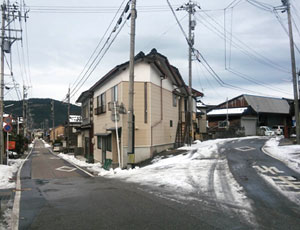
|
 |
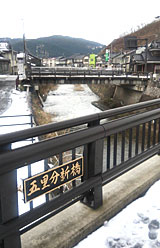 |
In a series of ten articles under the heading of Noto: Unsung Treasures, the architect Shinji Takagi, who was born and raised in Wajima in Ishikawa prefecture, seeks to identify some of the interesting buildings and their background, old local customs and various pieces of engaging landscape, all of which might not make it into a tourist guide but are nevertheless of considerable interest. (These articles were originally published in Japanese in volume 6~15 of the quarterly magazine Noto under the title of Sarigenai Fukei.) Goriwake Bridge Some 10 km east along the coast road from Wajima are the terraced paddies known as Senmaida. They are so representative of this area known as Noto Satoyama Satoumi and are registered by the Globally Important Agricultural Heritage System for their importance. A little further along the road is Sosogi, itself famous for its Madoiwa, an interesting coastal rock formation with a hole in it, hence literally “window rock”. Turning south here the Tokikuni house soon comes into view. This large reed thatched traditional building has been designated an Important Cultural Property by the Japanese Government. Forming a backdrop to this building is the verdure of Mt. Iwakura. Spreading out in front, however, is the river basin of the Machino River. This area of flat land with its air of pastoral calm is something of a rarity on the Noto Peninsula. At the centre of Machino stands the Goriwake Bridge spanning the Suzuya River. The present bridge is made of reinforced concrete but in the past, when the river was narrower, it was a wooden bridge. There were also a number of zelkova trees around it. It seems that one very fine specimen had a girth of 3.6 meters. It was here on hot days that many people used to sit in the shade and enjoy a moment's respite in the cool. Evidence of this can be seen in the local magazine from old black and white photographs. The bridge used to be called the Gori-gori Bridge as was situated at a point of about 20 km or five Ri in Japanese measurement, from both Iida and Ushitsu, both on the eastern coast of the peninsula. In the past Machino was an important and prosperous community along this overland route. After the disastrous floods during 1957, much improvement work was done on the rivers of Noto, so that now flood damage is far less common. As a consequence, however, there seems little or no chance of ever recreating the kind of pleasant, restful atmosphere that Goriwake Bridge and its trees afforded people in the past. |
 |
 |
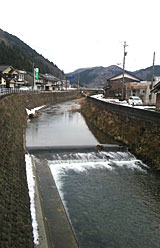 |
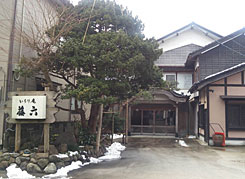 |
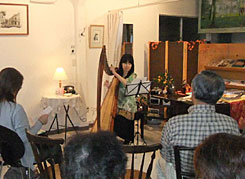 |
|
One of the roads near the bridge was called Dondoro. It was the main street of Machino and was flanked by pleasure houses, inns, a clinic, a soba noodle shop as well as an udon noodle shop, and a simple public bath. After the Second World War it seems there was also a theatre and a movie house too. Toward the end of the nineteenth century Haikaiムan early form of haiku poetryムwere very popular. It was then that many poets appeared here in Machino, and the area and scenery roundabout were greatly admired, thus giving rise to a number of well-known haiku. Poems extolling the merits of twelve scenes or events around Machino were published by Iwase company in a collection of work called Tamahiroi. The titles alone help us to imagine the poetic sentiment with which these scenes and events were charged at the time. Dondoro is a shadow of its former self now, despite having two bars and a well-known inn-cum-restaurant called Toroku. It seems, however, as if the quiet is gradually being broken. Now, for instance, there is a cafe of real character with a wood-burning stove. It is called Dondoro Poche. It is not the kind of place you would find in a big city. It has a more relaxed atmosphere and is a real “pocket”-poche from French-within the area. It not only draws the young as it has also become popular with the elderly as a place to meet for a quiet chat. There was an Irish harp concert for the opening of Dondoro Poche toward the end of last year. It was when the sweetly scented Osmanthus bushes were in bloom, which added to the intoxicating atmosphere of this wonderful concert and impression of Ireland it produced for all the people who were there.* |
Shinji Takagi---Architect Born in Wajima in 1942. Worked on many projects using local materials and true lacquer for shops, houses and a variety of interior design schemes. Principal work includes Yuyado Sakamoto in Suzu: the repair and renovation of the true lacquer craftsman's house, Nurishi no Ie in Wajima: Meiso no Yakata in Toga, Toyama prefecture: the store Kombuya Shirai in Nanao and Kanazawa: a store selling Japanese candles, Takazawa Shoten in Nanao. Member on the Wajima City Council for the Protection of Cultural Properties Committee. Director of the NPO, Ishikawa Reed Thatch Culture Study Group. Bill Tingey---Translator Chief Designer to David Hicks in London before moving to Japan in 1976 and gaining a Masters Degree in History of Architecture. Worked in Japan as a photographer, designer, writer and translator. Returned to UK to continue work in 2000. |
| (2015/5 Yuko Yokoyama) |
|
(C)Copyright 2004 Jomon-sha Inc, All rights reserved. |